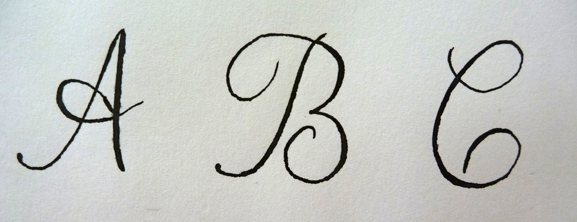
Many New Year’s resolutions fall flat because of unrealistic expectations, so I’ve simplified for 2012. The list is still under construction (hey, the Chinese New Year won’t arrive until the 23rd), but one thing is set: this year, during my off time between rehearsals and performances, I’m relearning the English alphabet.
Back in elementary school, the cursive alphabet was one of my greatest inspirations. My classroom had a laminated banner with letters from A to Z hanging over the chalkboard. Sometimes, when doing double division or editing run-on sentences became too much to bear, I would look up for guidance. And the cursive letters would smile in beneficence until all was well again.
My teacher taught us cursive in 3rd grade. I loved those lessons, finding a ceaseless joy and thrill in tracing the letters in my exercise book. Truthfully, they were shaky, trembling specimens—as if the alphabet had ingested an extra-strong double-shot espresso—but A reassured me that practice would make perfect, someday.
A and B were my best friends in class. They always tried to sneak home with me, usually by hiding on the last page of my tests or homework. My parents gladly gave them a place of honor at the dinner table. Unfortunately, this made C jealous. The next time I had a math test, he put himself in place of A and B. Mom had made A’s favorite dish and was disappointed by the uninvited guest. Dad was outraged by C’s rudeness and gave him the cold shoulder all night. Poor C rarely showed his face again.
In later years, teachers demanded typewritten papers to avoid bad handwriting. The computer screen forced A and I (the person, not the letter) into a long-distance relationship. Oh sure, we still shared secrets and created literary masterpieces, but something was different. We were drifting apart.
One day, I was drafting a thank you letter. Dear Sir, I thought I’d begin, then paused when my pen touched paper. For some reason, I couldn’t remember how to write a cursive D. Filling up half a page with possible candidates didn’t jog my memory, so I Googled it. The image results for cursive alphabets overwhelmed me with nostalgia.
Years of typing school papers had trained me to write in print. Sometimes a loop or a swirl would sneak in to accent my T or H, but I’d always feel slightly guilty afterwards. The classroom was no place for fancy letters. Even Century Schoolbook was derided as old-fashioned and dated. No, the hallowed halls of academia were ruled by the legions of Times New Roman and his cohorts, Veranda and Arial.
But deep down inside, I knew I was born to write in cursive. And so I began to look further into the past—to a time when accenting letters with flourishes was the norm. A time when pens were refilled by hand and a writer could be identified by the ink stains on his fingers.
A fountain pen was the first to reciprocate my efforts. She introduced me to her grandmother, a dip pen. Despite our differences in age, we quickly became friends. Now this venerable elder is teaching me the nuances of Copperplate—English round hand, a type of cursive-styled calligraphy.
If dance is like poetry in motion, then cursive is like waltzing with a pen. Each letter is a soloist whose curves, dots, or dashes swell with character and charisma. The words combine as dancing sentences, with the paragraph as their program and the page as the stage. For Chinese characters, the brush supersedes the western dip pen, yet both are fluent in the language of elegance and beauty.
Yesterday I tried to write a Copperplate “A”. One side was rough and blotchy, as if A had just woken up from a long, long nap. But the other side had an upturned curve, almost like a smile.

Jade Zhan
Contributing writer
17. בינואר 2012

